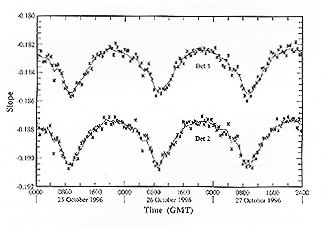Operational Calibration of the Imagers and Sounders
on the GOES-8 and -9 Satellites, Page 9
Michael Weinreb, Michael Jamieson, Nancy Fulton, Yen Chen, Joy Xie Johnson,
James Bremer, Carl Smith, and Jeanette Baucom
5. NOISE SUPPRESSION IN IMAGER BLACKBODY CALIBRATIONS
Although the effects of drift and 1/f noise in the Imagers' blackbody sequences are reduced
by the interpolation of the space-count value to the time of the blackbody view,
a significant amount of random variation (henceforth termed "noise") occurs in
the time series of computed calibration slopes. The asterisks in Figure 3
delineate the time series of slopes, computed every 30 min, from the two
detectors in channel 4 of the GOES-8 imager. Apart from noise, these plots
exhibit diurnal variation in the slopes with peak-to-peak amplitude of
approximately 2%. This is a true variation in instrument responsivity, caused
primarily by variations in the background radiation on the detectors. This is
expected, causes no errors, and will not be discussed further. However, the
noise is a problem. It induces errors in the radiances, and it also introduces
systematic striping11 in the images, which is often noticeable. The reader is
reminded that each of the two detectors in this channel generates alternate
lines of each image. The slope error for either detector induces a systematic
error in the radiance at every scene (pixel) observed by that detector for the
30 min following the calibration. Since these errors are, to a large extent,
uncorrelated between the two detectors, the systematic errors in the radiances
will usually be different for the two detectors, and the image will appear
striped. The characteristics of the striping will change every 30 minutes, as
the errors vary from one blackbody sequence to the next. The magnitude of the
striping in images from channel 4 of the GOES-8 imager is typically of the order
of 0.1K and 0.4K for scenes at 300K and 200K, respectively.
The calibration processing in the ground system applies an averaging technique to smooth out the
slope noise. It would not be desirable to average over a significant fraction of
a day, since that would introduce errors by removing true diurnal variation.
Instead, a two-hour running window is used. To achieve enough smoothing, we
include the slopes in the same two-hour interval from each of the previous nine
days. It is expected that the diurnal pattern of the slopes would not change
significantly over nine days. Data from more than nine days previous are not
included, because seasonal changes in the diurnal pattern may become significant
over such a long period and skew the average. The averaging includes the data
from the current time--for which the current slope and the slopes from the
previous hour are available; the data from the previous eight days--for which
slopes from five blackbody sequences in the full two-hour window centered on the
current time are available; and, finally, the data for the ninth day before the
current day--for which the slopes for the current time and one hour afterwards
are available. In the averaging, the slopes are weighted inversely according to
their displacement in time, both in days and in minutes within the two-hour
window, from the current blackbody sequence. Averaged slopes, plotted in Fig. 3
as the solid lines, reduce the scatter exhibited by the original slopes. The
averaging also reduces the frame-to-frame variation in striping11.

Fig. 3. Time series of calibration slopes for detectors 1 and 2 of channel 4 of
the GOES-8 Imager. Units of slopes are [mW/(m2-sr-cm-1)]/count.
Asterisks are unaveraged; solid lines, averaged.
Next | Previous | Table of Contents
Contact Michael P. Weinreb at michael.weinreb@noaa.gov
Latest Revision: July 9, 1997
